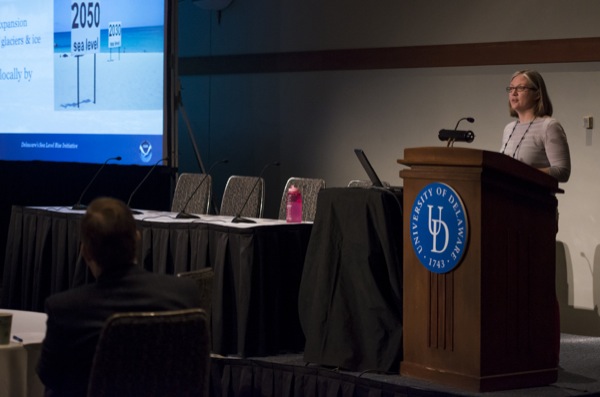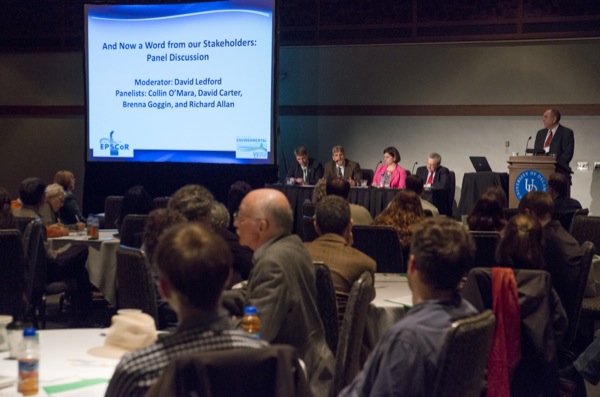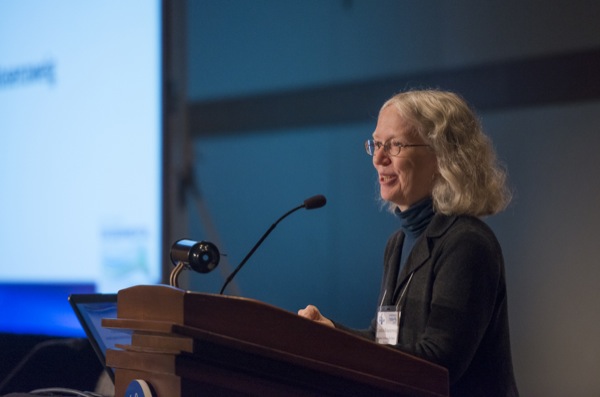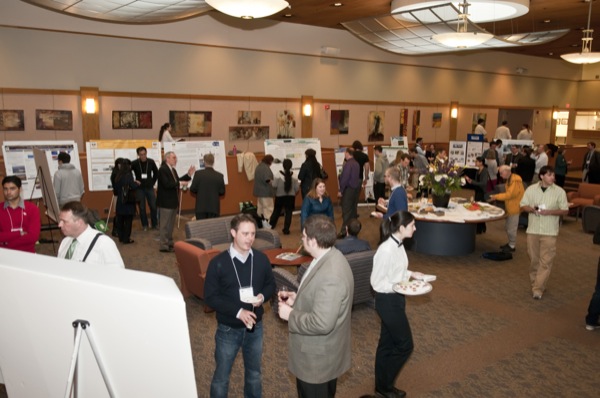


Threat from the sea
Symposium examines likely consequences, responses to sea level rise
1:11 p.m., March 20, 2013--Superstorm Sandy could be a tipping point for coastal states and municipalities in the Northeast, according to Cynthia Rosenzweig, keynote speaker at the DENIN Research Symposium and Delaware EPSCoR Annual Meeting held at Clayton Hall on March 12.
Speaking to about 130 participants at the symposium, which was titled “Coastal Consequences: Sea Level Rise in Delaware,” Rosenzweig said that for the first time, recovery efforts following the storm are incorporating plans for retreat from the coastline or other adaptations to rising sea levels, rather than just rebuilding.
Research Stories
Chronic wounds
Prof. Heck's legacy
Rosenzweig is a senior research scientist at the Goddard Institute for Space Studies at Columbia University. At Goddard, she leads the Climate Impacts Group, whose mission is to investigate the interactions of climate (both variability and change) on systems and sectors important to human well-being.
She was the lead scientist on the New York City Department of Environmental Protection Climate Change Task Force, which has advised Mayor Michael Bloomberg about possible impacts from climate change and actions that may be needed to adapt.
Rosenzweig also pointed out that few impacts of Sandy were unanticipated. Reports prepared as far back as 2001 had predicted which areas of New York were likely to be flooded, for example, or that certain hospitals were especially vulnerable to power outages.
James Kendra, director of the University of Delaware’s Disaster Research Center, concurred during an afternoon session on “Lessons Learned from Sandy and Other Recent Storms in Delaware” that the experience of Sandy provided little new information for the disaster response community in Delaware.
Throughout the day, speakers reiterated that Delaware’s vulnerabilities to coastal storms and sea level rise are fairly well known, but that the state must now grapple with how best to distribute limited resources in order to help residents prepare and respond to rising seas.
Steps have already been taken in that direction, through a 24-member Sea Level Rise Advisory Committee, which recently published a report highlighting the risks of sea level rise in Delaware and suggesting more than 60 options for state leaders to consider implementing in the future.
Susan Love, a planner with the Delaware Coastal Programs section of the Delaware Department of Natural Resources and Environmental Control (DNREC), works closely with the committee and presented the group’s findings at the symposium. She pointed out that even though most Delawareans do not live at the beach, the state is small enough and flat enough that all residents of the state will eventually be affected by sea level rise, whether through increased likelihood of flooding or through other effects such as saltwater intrusion into drinking water supplies.
Rates of sea level rise in Delaware, as in most of the Mid-Atlantic region, are occurring faster than the global average because of the geology of the region, Love said. Not only is sea level rising, but the land is also sinking. According to the advisory committee’s report, Delaware stands to lose 8 to 11 percent of its land area to inundation by 2100 at rates of sea level rise currently predicted by scientists.
Delaware’s three counties are likely to experience sea level rise in quite different ways, according to symposium speakers. For example, the Sussex County Atlantic beaches, which are big contributors to the tourism economy of Delaware, are likely to be sustainable through sand replenishment projects for quite some time.
Residents of coastal communities along Delaware Bay, in Kent County, however, often feel their needs are not being responded to at the same level, according to Prime Hook Beach resident Richard Allan, who took part in a panel discussion featuring coastal stakeholders at the symposium. Many long-time residents bought their property in these communities well before the threat of sea level rise was apparent. Allan suggested a coastal security tax could help provide the funds needed to assist residents and help maintain or move coastal infrastructure.
In New Castle County, a different problem emerges due to the more industrial history of the area. Low-lying neighborhoods such as South Wilmington feature both contaminated soils in old industrial sites and high levels of poverty among residents. The afternoon session on “Environmental Justice and Sea Level Rise” featured a presentation by UD doctoral candidate in public policy and administration Kevin Adkin, whose dissertation work focused on the risks and needs of South Wilmington residents.
Future flooding from sea level rise may liberate contaminants that are currently bound to soil particles, Adkin said, thus posing health risks to city residents who have few resources for responding to the problem. His work culminated in a report to Wilmington city officials and state offices that provided policy recommendations for South Wilmington and other similarly vulnerable areas.
The symposium also served as the annual meeting of the Delaware EPSCoR program. Student and faculty research projects that have been funded during the past year through EPSCoR seed grants and research internships were featured in the accompanying poster session and in several videos screened during the day.
National Science Foundation EPSCoR program director for Delaware EPSCoR, Sean Kennan, presented changes in NSF’s proposal review criteria for “broader impacts” and highlighted upcoming proposal solicitations of interest to researchers in Delaware.
PowerPoint slides from many of the presentations are available for viewing on DENIN’s event website.
Article by Beth Chajes
Photos by Kathy F. Atkinson and Doug Baker











